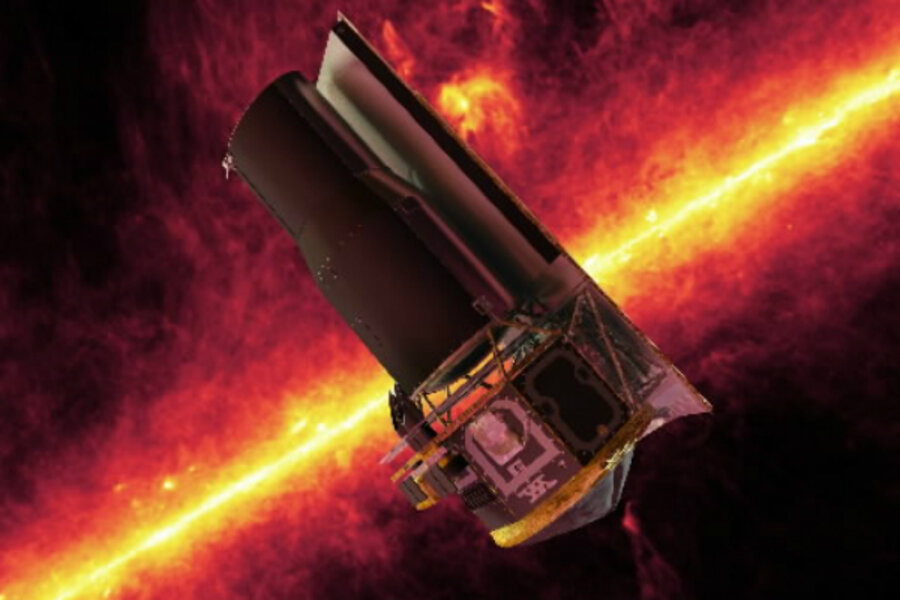Are last rites in order for NASA's Spitzer Space Telescope?
Loading...
The Spitzer Space Telescope, one of NASA's four space-based "Great Observatories," may be on the ropes, but it's not down for the count quite yet.
A revised budget for the telescope should reach NASA headquarters next week in a bid by project managers to keep the telescope operating for at least another two years.
In April, a NASA advisory panel had reluctantly recommended that the space agency shut down the highly productive telescope, unless it could find a way to reduce the program's cost, currently running at $16.5 million a year.
Launched in 2003, Spitzer initially observed the cosmos at infrared wavelengths, observing the birthplaces of stars, obscured from view at other wavelengths by dust and gas. It also observed stars surrounded by discs of dust that would become planets. And it peered deep into the past, looking at galaxies whose light have been stretched from visible and even ultraviolet wavelengths into the infrared by the expansion of the universe.
To achieve the sensitivity to make those observations, its detectors had to be chilled by liquid helium. When the helium ran out at the end of 2009, Spitzer shifted its view to near-infrared wavelengths and has increasingly been harnessed to study extrasolar planets.
In the report, released May 19, the science-review panel (SRP) noted that the observatory's science program remains strong and, at least for now, unique. It is fulfilling objectives the agency had set for its astrophysics research program. And it still dovetails with other NASA and European Space Agency astrophysics missions in important ways.
But tight budgets at NASA, a successful run that has lasted far longer than the telescope's original 2.5-year mission, and a telescope that now can use only one of its original three instruments led the panel to recommend that it be canceled unless substantial cuts, below the $1.2 million reduction the program itself offered up, could be made.
Even as the panel made its recommendation on Spitzer, as well as eight other astrophysics missions seeking extensions, it was clear it did so while holding its nose.
"The operation of the nation’s space-borne observatories is so severely impacted by the current funding climate in Washington that the SRP feels that American preeminence in the study of the universe from space is threatened to the point of irreparable damage if additional funds cannot be found to fill the projected funding gaps," the panel wrote.
One measure of the observatory's popularity among astronomers: demand for time on the sky. Over the past two years in particular, demand has been far outpacing supply, says Lisa Storrie-Lombardi, manager of the Spitzer Science Center at the California Institute of Technology in Pasadena, Calif. The center runs the telescope's science operations – weighing project-proposals for telescope time, scheduling research projects, and otherwise serving as the science community's point of contact for Spitzer.
Throughout the so-called "warm" mission, Spitzer has spent more than 7,000 hours a year observing, Dr. Storrie-Lombardi says.
Even with one instrument remaining on the telescope, "the number of hours requested versus the number of hours available has been the highest it's ever been in the mission," she says, with the total number of hours requested outpacing the hours available by 6 or 7 to 1.
Meanwhile, since the shift to the warm mission, tight budgets have led to a staff only one-third its initial size, while the program's budget has fallen by 25 percent.
"If we were oversubscribed by only 2 to 1 and not doing really exciting science, I would completely understand if NASA said: You know, a few million dollars is a lot of money; we'll do something else with it," Storrie-Lombardi says.
At the same time, considering the budget challenges NASA faces and the Solomon-like task the science review panel faced, "it's not hard to see how this might have been one of the outcomes," she adds.
Neither NASA nor the advisory panel have provided any guidance on a spending target the Spitzer team should try to hit.
Instead the team has started with the panel's guidance that the observatory should service a wide range of projects demanding an equally wide range of observing time – from a few hours to a couple of thousand hours.
The $15.3 million the team initially proposed for another extension is "pretty close to the floor," Storrie-Lombardi says. "So we're looking again at the budget we submitted for anything else we think we could trim without imperiling the health and safety of the observatory," while allowing the program to support most of the general observing projects.
It's not clear how long NASA will take to consider the program's revised spending plan, but the agency's general budgeting schedule suggests that the team – and the long queue of scientists relying on the observatory – could have an answer by the end of June.






